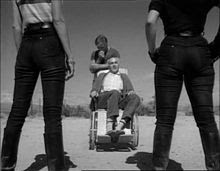YouTube viewing
You have to hand it to Russ Meyer. He knew exactly what he wanted to see in his movies, and he got it, time and time again: sexy chicks with big tits—yet his films weren’t pornos, and sometimes, they weren’t even erotic. His women weren’t put on pedestals; they were active and did things; sometimes bad things, true, but they were rarely boring.
As a cartoonist, I’ve drawn sexy girls in the past for my own amusement, and occasionally for publication, sometimes clothed, other times not. I’ve wanted to make an erotic comic book; I even wrote a script for a story about a stripper, but I never had the cojones to actually draw it and publish it.
Putting one’s sexual fantasies on display is not an easy thing, not even these days, where public exhibitionism is more common than ever thanks to the internet. I know the things that turn me on are not as unusual as I once might’ve thought (and none of your beeswax), but in my prose at least, I’ve loosened up somewhat in that category thanks to a writer friend whose stories have lots of steamy sex scenes. She and I have had long conversations on the subject. Still, I’m no E.L. James by any stretch.
Being attracted to sexual imagery and afraid of it at the same time has been the American way for generations, and it’s certainly been a long-running subplot in the history of film. The underground cinema of the 50s and 60s chafed at the restrictions against nudity and depictions of sexuality in general, and Meyer was one of the filmmakers at the vanguard.
Meyer was a combat cameraman in the army during WW2 and worked for Hugh Hefner and Playboy afterwards as a photographer, which is how he met his second wife and longtime film collaborator Eve, a former Playmate of the Month.
Nudity in film certainly did not begin with Meyer. “Naturist,” or nudist camp films, for example, go back as far as the 30s, but when Meyer made The Immoral Mr. Teas in 1959 (in color), it was the first time nudity was put in the context of sexual arousal. They called movies like this “nudie cuties”—Coppola made a couple before he broke through—and in Meyer’s case, he struck gold. I watched a little bit of it before deciding against writing about it; by today’s standards, it’s pretty tame. It’s like a cross between Jacques Tati and Benny Hill.
Meyer made some more films in a similar vein, putting Eve in one, but when the market dried up for nudie cuties (Jayne Mansfield had already shown her tits in Promises! Promises!), he changed his approach. He switched to black and white for Lorna (a hit), Mudhoney and Motorpsycho! (also a hit).
Faster Pussycat Kill Kill was a result of Meyer’s previous film, Motorpsycho (an influence in the making of The Wild Angels), which had three male antihero protagonists. Meyer just decided to do one with three female antiheroes. He co-wrote it with frequent collaborator Jack Moran but it was sound editor Richard S. Brummer who came up with the provocative title. Meyer liked it because it implied speed, sex and violence all in one.
In rewatching this movie, it struck me for the first time that despite its outdoor desert setting, it could be considered a film noir: three amoral femme fatales, on the run after killing a man and kidnapping his girlfriend; a scheme to make some money through a robbery; a betrayal; violent deaths—in another time, based on the plot alone, this might have been a Nicholas Ray movie, or maybe even Fritz Lang. Jane Russell in the Tura Satana role, perhaps?
I had forgotten how thrilling this movie is, especially in the second half, when Satana’s scheme to steal the old man’s money comes undone due to dissension in the ranks, if you will. Other Meyer movies have more nudity—you don’t see anything noteworthy in Pussycat—but after awhile you forget about that.
Pussycat tanked upon its initial release, but obviously time has been very, very good to it, partly because of succeeding generations of film fans who looked at it differently, partly due to a change in the zeitgeist. As we’re seeing these days, women in movies are capable of much more, and though the protagonists in Pussycat are not heroic by any stretch, they’re absolutely riveting to watch—and not just because of the size of their bazooms.






No comments:
Post a Comment
Note: Only a member of this blog may post a comment.